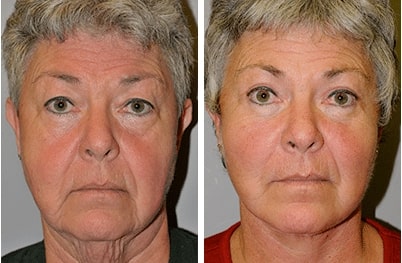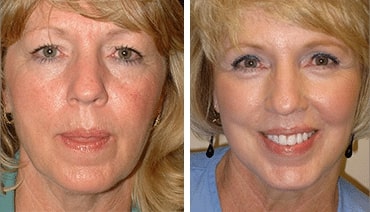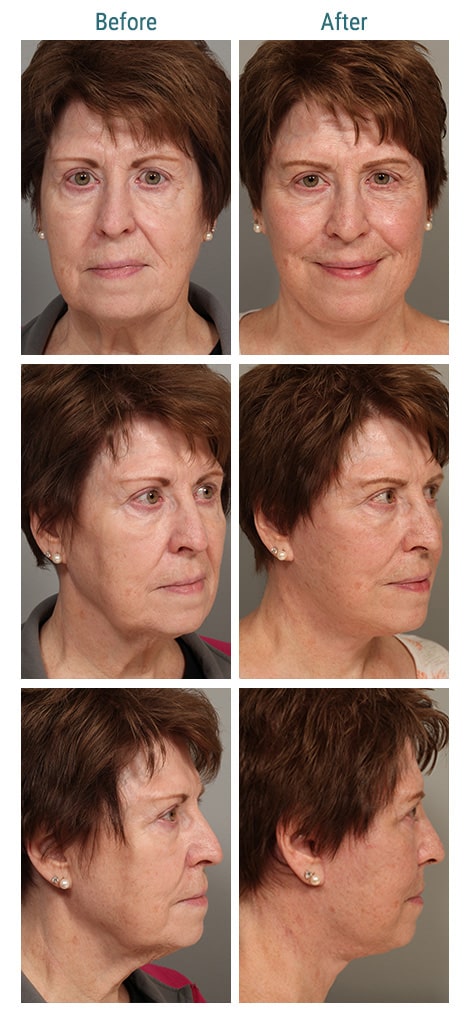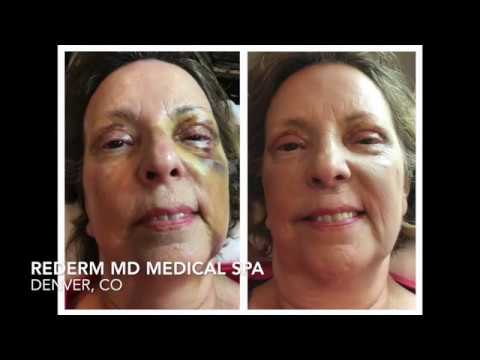Facelift

A facelift is a plastic surgery procedure that tightens the tissues of the lower two-thirds of the face. It's effective for jowls, blurring of the jawline, sagging cheeks, and wrinkles that run from the sides of the nose to the corners of the mouth. In general, a facelift is performed to fix that droopy, sad look that belies our natural good spirits. It is often, but not always, combined with a neck lift since the neck often sags and wrinkles.
A facelift may be all you need. However, for many people, facelifts are performed in conjunction with other procedures, such as blepharoplasty (eyelid surgery), laser resurfacing, fat grafting, or Botox® injections. At Fante Eye & Face Centre, where we have served patients in Colorado for over 20 years, our doctors will listen to your wishes and advise you on how you can best arrive at the look you want. A facelift can take about 10 years off your apparent age.
What is a Facelift?
There are some different types of ways to get a “facelift”.
- Traditionally it meant work on the jawline and neck, pulling them upwards to improve sagging, wrinkles, and jowls.
- The term “full facelift” is sometimes used to mean the above, plus improvement in the upper cheeks as well.
- In more recent years, the term has been used as a catch-all for any customized combination of procedures on the face, all of which are localized and specific. For example, you could have combinations such as:
- Lip augmentation and a neck lift;
- Cheek lift and laser skin resurfacing; or
- Eyelid surgery and a brow lift.
In general, you could define a facelift or “rhytidectomy” as a plastic surgical procedure on the lower two-thirds of the face to improve the most visible signs of aging. A facelift counteracts these signs by removing sagging skin, elevating the facial muscles and fat, tightening the muscles beneath the skin of the neck, and often removing excess fat from the neck.
Would I Be a Good Candidate for a Facelift?
If you are:
- Over 30
- In good general health
- Are not a longtime smoker
- Willing to be realistic about the potential
you’re likely a candidate for some kind of facelift. The best candidates for a facelift want to correct more than one of the signs of aging. In recent years, younger people have been asking for them, and although a younger person can heal more quickly, there’s no ideal age for a facelift.
Dr. Fante will explain all the possible procedures for your particular face and together you can arrive at the best one, or the best combination of procedures.
Facelift Before and After Photos


Facelift Plastic Surgery Procedure
To start the facelift procedure, an incision is made on each side of your face. The incision typically begins behind the hairline near the temple, runs down in front and inside of the ear, and back behind the ear into the hairline. Another small incision may be hidden inside your upper lip and permits Dr. Fante to work also with your cheeks for the best and most natural facial harmony.
From there, the fat and soft tissues are elevated, the muscles are tightened, excess skin and tissue removed, and the incision closed with very fine stitches or small metal clips. Dr. Fante uses his extensive knowledge of facial anatomy to employ advanced techniques that improve the three-dimensional contours of your face while minimizing potential problems.
Facelift FAQ Video

Combining a Facelift With a Neck Lift
If you have a neck lift or neck liposuction at the same time, there may be a small incision under the chin. A facelift and neck lift is often combined with liposuction for the fatty pad that gradually forms under the chin as we age.
In the early days of facelifts, only the skin was tightened, leaving the tissue beneath the skin, consisting of muscle and fat, with associated blood vessels, nerves, etc. as is. That made for a “tightened” look, that expression of perpetual surprise that we all want to avoid. In present-day facelifts, the tissue beneath the skin (SMAS) is involved too, so that the results are more natural, longer-lasting, and more individualized.
What is the SMAS?
SMAS stands for Sub-Muscular Aponeurotic System. And what’s that? It’s the tissue beneath the skin, consisting of muscle and fat, with associated blood vessels, nerves, etc.
In the early days of facelifts, only the skin was tightened, leaving the SMAS as is. That made for a “tightened” look, that expression of perpetual surprise that we all want to avoid.
In present-day facelifts, the SMAS is involved too, so that the results are more natural, longer-lasting, and more individualized.
How Long Does a Facelift Take?
The procedure takes about 2 to 4 hours under either local anesthetic and IV sedation, or with general anesthesia. Many people will choose general anesthesia. In any case, Dr. Fante will always combine local anesthesia with either choice to minimize your need for medications. You can discuss the alternatives with during your consultation.
Facelift Recovery
Dr. Fante will give you written instructions for your recovery period. He’ll also prescribe an antibiotic and pain medication for a short period. There’s usually not much pain but you’ll be given a prescription for pain medication just in case. Swelling and bruising will subside within the first few weeks.
Dr. Fante will wrap your lower face and upper neck in dressings and a spandex garment when you leave the surgery center. Dr. Fante will instruct you to wear the spandex facial garment and to sleep with your head elevated, for the first week. Use pillows to prevent your head from turning while you sleep and use ice packs for the first day or two to minimize swelling.
Dr. Fante will remove your sutures about one week after surgery. Incisions will fade to white, barely visible scars which can be further hidden with makeup. They are strategically placed partly under your hair, inside your ears, and/or within the normal creases of your skin. Temporary feelings of tightness and numbness disappear with a few weeks. Most people return to work after 10 to 14 days. You can start wearing makeup at about 10 days, but it may take more than 2-3 weeks for you to look your best.
Recovery may take longer depending on how extensive your facelift is. Minimal facelifts have a quicker and easier recovery while facelifts combined with other procedures potentially involve longer swelling, slower recovery and slightly more risk for complications.
Facelift Before and After Photos

Returning to Normal Activities After a Facelift
After surgery, you should rest at home, but you don’t need to stay in bed all the time. Most people feel a little tired but pretty well overall, and can take a walk or go out (perhaps with sunglasses and a hat!) within the first few days.
You can shower and wash your hair two days after surgery. Avoid vigorous physical activity such as prolonged bending, heavy lifting, and sexual activity, for at least 2 weeks. In addition, use alcohol only sparingly for the first two weeks.
Make-up Camouflage for Bruising After Surgery

What to Avoid After Facelift Surgery
Don’t have any dental procedures done for at least 6 weeks, unless you need some kind of emergency care.
Don’t use any of these things for 3 weeks:
- Tobacco products (including nicotine gum and patches)
- Aspirin
- Non-steroidal anti-inflammatory agents
- Vitamin E
Facelift Scarring
All incisions leave scars. Scars fade over time, although it might take most of a year for the final results to be visible.
Facelift incisions are largely behind the hairline and therefore will leave barely visible scars. If they’re also around the ear, your hair can cover them pretty well there too.
Another factor with scars is that all patients are different when it comes to scarring. Heredity plays a role, and the exact outcome isn’t totally predictable in individual cases. However, it’s possible to repair scars that are too prominent, with further minor surgery.
Is a Facelift Permanent?
After you recover, you’ll look more youthful and rested. Gradually as you continue to age over the next few years, the tissues will relax. You’ll look better than you would have without the surgery for about 10 years.

Types of Facelifts
Many people may be surprised to know that there are multiple variations of the Facelift Procedure. These different types can be referred to as:
- Traditional Facelift
- Deep Plane Facelift
- Platysmaplasty
- Mid-Facelift
- Subperiosteal Lift
- Skin Lift
- Mini-Facelift
Can a Facelift Fix Facial Asymmetry?
A facelift can help address certain aspects of facial asymmetry, particularly those caused by sagging skin or volume loss.
During the procedure, excess skin is removed, and underlying tissues are tightened. This can result in a more balanced appearance.
However, if asymmetry is due to bone structure or muscle imbalances, additional procedures like fat grafting or fillers may be recommended. A thorough consultation with one of our surgeons will determine the best approach to achieve a more symmetrical look.
How Soon Can I Fly After Facelift Surgery?
It's generally advised to wait at least 10 to 14 days before flying after a facelift.
Air travel shortly after surgery can increase the risk of swelling, discomfort, and complications. This is due to changes in cabin pressure and the potential for blood clots from prolonged sitting.
Additionally, patients should ensure they've followed up with their surgeon before flying. This allows them to confirm that their healing is progressing as expected.
Will a Facelift Affect My Facial Expressions?

A well-executed facelift should not affect your ability to make natural facial expressions. Skilled surgeons like Dr. Fante, Dr. Echalier, and Dr. Levitt take great care to preserve the muscles and nerves that control expression.
Modern facelift techniques also focus on lifting deeper layers of tissue rather than just tightening the skin. This helps maintain a natural, youthful appearance while retaining a full range of motion for facial expressions.
How Can I Maintain My Facelift Results Over Time?
To maintain facelift results, it's important to adopt a solid skincare routine. It should include moisturizing and sun protection.
You may also want to incorporate medical-grade treatments like lasers or chemical peels. Non-surgical treatments such as fillers and Botox® Cosmetic can also prolong the effects.
Maintaining a healthy lifestyle, avoiding smoking, and protecting your skin from sun damage will help your facelift results last longer, as well.
Is It Safe To Undergo a Facelift if I've Had Previous Facial Surgery?
It is generally safe to undergo a facelift if you've had previous facial surgery. However, it depends on factors such as:
- The type of surgery
- The time elapsed
- The condition of the underlying tissues
During your consultation, your surgeon will evaluate your surgical history, scar tissue, and skin elasticity to determine the best approach.
While secondary facelifts are common, the procedure may be modified to account for any prior interventions. Choosing an experienced surgeon is essential for achieving optimal results and minimizing risks in such cases.
Why Choose Fante Eye & Face Centre?
Fante Eye & Face Centre has proudly served Colorado for over 20 years, providing superior cosmetic surgery services – as well as reconstructive surgery and non-invasive treatments – to patients throughout the Rocky Mountain region.
With a comfortable mid-town Denver office suite, Dr. Fante, Dr. Echalier, and Dr. Levitt offer a welcoming environment for every patient. Their commitment to quality care is enhanced by having the latest equipment onsite, ensuring that patients receive state-of-the-art treatments.
Whether you're seeking advanced cosmetic solutions or specialized eye care, Fante Eye & Face Centre's experience and expertise make them the ideal choice.
Schedule a Consultation
If you are interested in a facelift and would like more information, contact our Denver office today! Call (303) 839-1616 to schedule a consultation with board-certified plastic surgeons Dr. Robert Fante or Dr. Alexandra Levitt. You can also fill out the Contact Us form on this page, and our talented team will help you set up your appointment. Our practice looks forward to serving you!


